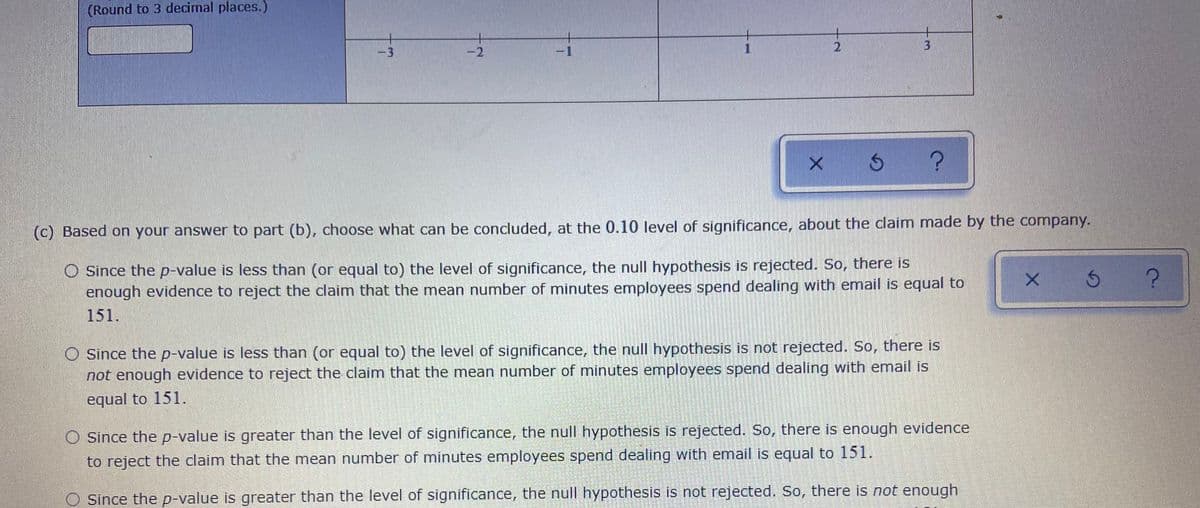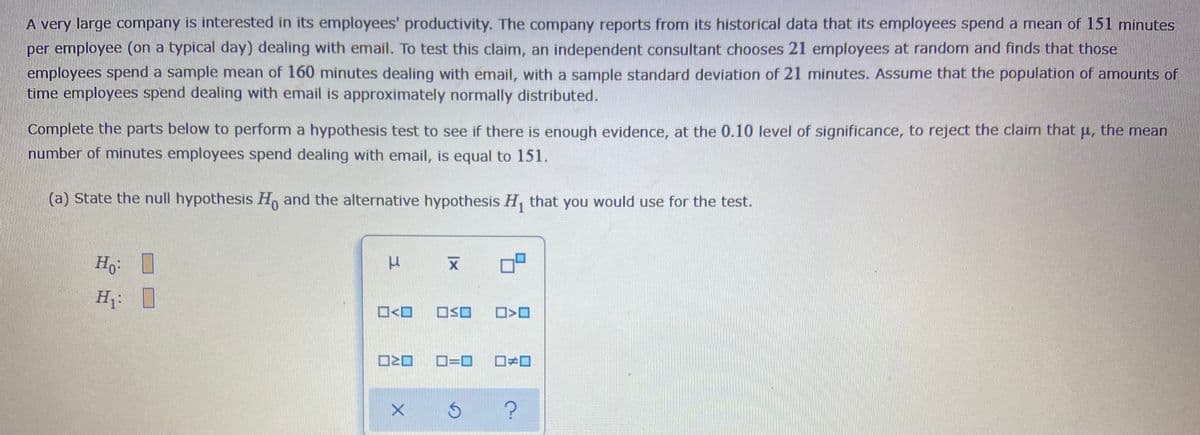A very large company is interested in its employees' productivity. The company reports from its historical data that its employees spend a mean of 151 minutes per employee (on a typical day) dealing with email. To test this claim, an independent consultant chooses 21 employees at random and finds that those employees spend a sample mean of 160 minutes dealing with email, with a sample standard deviation of 21 minutes. Assume that the population of amounts of time employees spend dealing with email is approximately normally distributed. Complete the parts below to perform a hypothesis test to see if there is enough evidence, at the 0.10 level of significance, to reject the claim that u, the mean number of minutes employees spend dealing with email, is equal to 151. (a) State the null hypothesis H and the alternative hypothesis H, that you would use for the test. Ho: I H: I OSO O=0
A very large company is interested in its employees' productivity. The company reports from its historical data that its employees spend a mean of 151 minutes per employee (on a typical day) dealing with email. To test this claim, an independent consultant chooses 21 employees at random and finds that those employees spend a sample mean of 160 minutes dealing with email, with a sample standard deviation of 21 minutes. Assume that the population of amounts of time employees spend dealing with email is approximately normally distributed. Complete the parts below to perform a hypothesis test to see if there is enough evidence, at the 0.10 level of significance, to reject the claim that u, the mean number of minutes employees spend dealing with email, is equal to 151. (a) State the null hypothesis H and the alternative hypothesis H, that you would use for the test. Ho: I H: I OSO O=0
MATLAB: An Introduction with Applications
6th Edition
ISBN:9781119256830
Author:Amos Gilat
Publisher:Amos Gilat
Chapter1: Starting With Matlab
Section: Chapter Questions
Problem 1P
Related questions
Question

Transcribed Image Text:(Round to 3 decimal places.)
+
3.
-3
2
1
(c) Based on your answer to part (b), choose what can be concluded, at the 0.10 level of significance, about the claim made by the company.
O Since the p-value is less than (or equal to) the level of significance, the null hypothesis is rejected. So, there is
enough evidence to reject the claim that the mean number of minutes employees spend dealing with email is equal to
151.
Since the p-value is less than (or equal to) the level of significance, the null hypothesis is not rejected. So, there is
not enough evidence to reject the claim that the mean number of minutes employees spend dealing with email is
equal to 151.
O Since the p-value is greater than the level of significance, the null hypothesis is rejected. So, there is enough evidence
to reject the claim that the mean number of minutes employees spend dealing with email is equal to 151.
Since the p-value is greater than the level of significance, the null hypothesis is not rejected. So, there is not enough

Transcribed Image Text:A very large company is interested in its employees' productivity. The company reports from its historical data that its employees spend a mean of 151 minutes
per employee (on a typical day) dealing with email. To test this claim, an independent consultant chooses 21 employees at random and finds that those
employees spend a sample mean of 160 minutes dealing with email, with a sample standard deviation of 21 minutes. Assume that the population of anmounts of
time employees spend dealing with email is approximately normally distributed.
Complete the parts below to perform a hypothesis test to see if there is enough evidence, at the 0.10 level of significance, to reject the claim that u, the mean
number of minutes employees spend dealing with email, is equal to 151.
(a) State the null hypothesis H, and the alternative hypothesis H, that you would use for the test.
H:
O<O
OSO
O=D
Expert Solution
This question has been solved!
Explore an expertly crafted, step-by-step solution for a thorough understanding of key concepts.
This is a popular solution!
Trending now
This is a popular solution!
Step by step
Solved in 3 steps with 1 images

Recommended textbooks for you

MATLAB: An Introduction with Applications
Statistics
ISBN:
9781119256830
Author:
Amos Gilat
Publisher:
John Wiley & Sons Inc

Probability and Statistics for Engineering and th…
Statistics
ISBN:
9781305251809
Author:
Jay L. Devore
Publisher:
Cengage Learning

Statistics for The Behavioral Sciences (MindTap C…
Statistics
ISBN:
9781305504912
Author:
Frederick J Gravetter, Larry B. Wallnau
Publisher:
Cengage Learning

MATLAB: An Introduction with Applications
Statistics
ISBN:
9781119256830
Author:
Amos Gilat
Publisher:
John Wiley & Sons Inc

Probability and Statistics for Engineering and th…
Statistics
ISBN:
9781305251809
Author:
Jay L. Devore
Publisher:
Cengage Learning

Statistics for The Behavioral Sciences (MindTap C…
Statistics
ISBN:
9781305504912
Author:
Frederick J Gravetter, Larry B. Wallnau
Publisher:
Cengage Learning

Elementary Statistics: Picturing the World (7th E…
Statistics
ISBN:
9780134683416
Author:
Ron Larson, Betsy Farber
Publisher:
PEARSON

The Basic Practice of Statistics
Statistics
ISBN:
9781319042578
Author:
David S. Moore, William I. Notz, Michael A. Fligner
Publisher:
W. H. Freeman

Introduction to the Practice of Statistics
Statistics
ISBN:
9781319013387
Author:
David S. Moore, George P. McCabe, Bruce A. Craig
Publisher:
W. H. Freeman